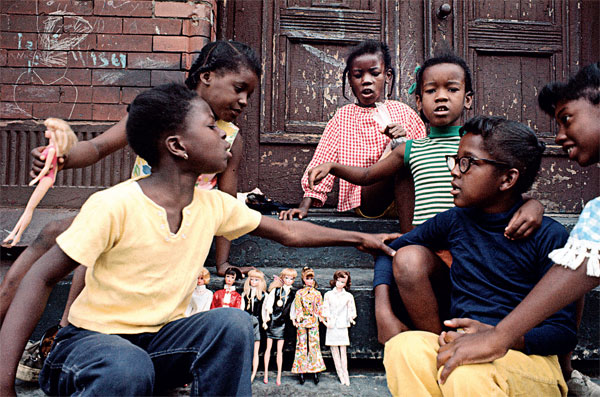Tracking Changes: Harlem through the lens of Vergara
By Elydia Barret

Girls and Barbies, East Harlem, 1970
A group of black girls is sitting on the stoop of a building whose crumbled facade is covered in graffiti. They are so absorbed in their play that they practically do not pay attention to the photographer. Their movements create a loop that ends with a white blonde Barbie doll, echoing a row of others Barbies carefully arranged on the steps, in the center of the image. Camilo José Vergara’s photos are not only beautiful, they are extraordinarily meaningful. In a fresh and lively way that confers a great value to his photographs, he succeeds in capturing and encapsulating an everyday-life scene together with a whole society’s state of mind.
On February 19, 2014,in the context of its spring lectures, the Herbert H. Lehman Center for American History invited Vergara to introduce his newly released book, Harlem: The Unmaking of a Ghetto (The University of Chicago Press, 2013).
Born in 1944 in Chile, Vergara moved to New York in the early seventies and, inspired by the work of Helen Levitt, devoted himself to street photography. When jumping into graduate work in sociology (he earned an M.A. in sociology from Columbia University in 1977), he became aware of the close and complex connections between urban environment and social behavior.
This emerges as a turning point in the work of Vergara who, adopting sociological methodologies, began to use the process of “re-photography” from then on. By photographing the same locations at regular intervals over the course of decades in a systematic way, Vergara tracks and records the incremental urban as well as socioeconomic changes of poor neighborhoods in major urban centers of the United States such as Los Angeles, California; Detroit, Michigan; Chicago, Illinois; the South Bronx of New York City or Camden, New Jersey.
Harlem hasn’t escaped from his sensitive lens. Through enthralling sequences of pictures, Vergara intermingled Harlem folks’ individual stories with the last 40 years of Harlem’s history. This visual chronicle emphasizes the incredibly rapid changes this district has experienced since the late seventies, as this series of photos of 65 East 125th St. illustrates.
As Vergara explained it himself, his book intends to keep records and, with some kind of nostalgia, to resuscitate a disappearing Harlem. But his work also provides powerful material that allows comprehending the nonlinear development of this vibrant neighborhood in geographical, urban, social or intellectual terms. Browsing the shots, we get a strong sense of the heterogeneous and unpredictable nature of Harlem: some areas decaying as longtime businesses close, while other areas gentrify with chain stores setting up.
Captured by the photographer, the built environment turns out to be a strong medium of expression for Harlem voices. Buildings, storefronts, monuments, graffiti, and streets in general let Harlem’s community be heard, and thus witness its evolving approach to crucial topics as racial issues or the African-American past.
Elydia Barret is currently in training at the Ecole Nationale des Sciences de l'Information et des Bibliothèques, the French national school for library and information sciences based in Lyon, France. She is delighted to be hosted as an intern at the RBML for three months and to get the opportunity to be involved in its projects.